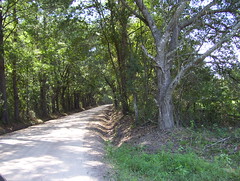“from a traffic safety perspective, the modern commercial arterial is a perfect storm of bad planning and design. These roads are designed to support high operating speeds, making it difficult for drivers to stop quickly to avoid a crash, and the presence of commercial and retail uses on these roads means that drivers will routinely need to stop quickly in order to avoid crashing into pedestrians, bicyclists, and especially vehicles turning in and out of driveways.”The 2006 article, Safe Urban Form: Revisiting the Relationship Between Community Design and Traffic Safety, by Eric Dumbaugh and Robert Rae, notes: Continue reading
Tag Archives: pedestrian
Trees make streets safer
 Beta New Urban Network reported 1 September 2006 that
Research: trees make streets safer, not deadlier:
Beta New Urban Network reported 1 September 2006 that
Research: trees make streets safer, not deadlier:
Proposals for planting rows of trees along the roads — a traditional technique for shaping pleasing public spaces — are often opposed by transportation engineers, who contend that a wide travel corridor, free of obstacles, is needed to protect the lives of errant motorists.The study asks a key question: Continue readingIncreasingly, however, the engineers’ beliefs about safety are being subjected to empirical study and are being found incorrect. Eric Dumbaugh, an assistant professor of transportation at Texas A&M, threw down the gauntlet with a long, carefully argued article, ”Safe Streets, Livable Streets,” in the Summer 2005 issue of the Journal of the American Planning Association. A follow-up article by Dumbaugh, in the 2006 edition of Transportation Research Record, will present further evidence that safe urban roadsides are not what the traffic-engineering establishment thinks they are.
Though engineers generally assert that wide clear areas safeguard motorists who run off the roads, Dumbaugh looked at accident records and found that, on the contrary, wide-open corridors encourage motorists to speed, bringing on more crashes. By contrast, tree-lined roadways cause motorists to slow down and drive more carefully, Dumbaugh says.
Dumbaugh examined crash statistics and found that tree-lined streets experience fewer accidents than do “forgiving roadsides” — those that have been kept free of large, inflexible objects. He points to “a growing body of evidence suggesting that the inclusion of trees and other streetscape features in the roadside environment may actually reduce crashes and injuries on urban roadways.”
“Your streets are designed to kill people.”
 Roads that are designed to kill,
By Mark Rosenberg,
August 18, 2009:
Roads that are designed to kill,
By Mark Rosenberg,
August 18, 2009:
They said the speed limit should be 30 kilometers per hour (about 18.6 miles per hour) or less if we wanted pedestrians to have much of a chance of surviving.That’s what people in Sweden say. In their country, roads are actually designed to be safe. Unlike ours:
“This is where you live? This is your neighborhood? Your streets are designed to kill people.’’It’s not hard to find descriptions of Sweden’s Vision Zero for no road deaths:
Vehicle speed is the most important regulating factor for safe road traffic.Hm, so slower is safer.
Quarterman Road (like many other rural roads in Lowndes County) is a local neighborhood road, with tractors, bicycles, dogs, deer, and mothers rolling babies in strollers. According to Claes Tingvall, Director of Traffic Safety, Swedish Road Administration:
The idea of ”shared space” between pedestrians and vehicles has been trialed successfully in Gothenburg and other cities, as long as the environment has been redesigned for slow traffic.And a budget-conscious county may be interested that he also says this:
The new safety principle, to control kinetic energy, is by itself cheaper than accident prevention. And once that investment is made it produces benefits every year.Not to mention the benefit of fewer traffic accidents, injuries, and deaths.